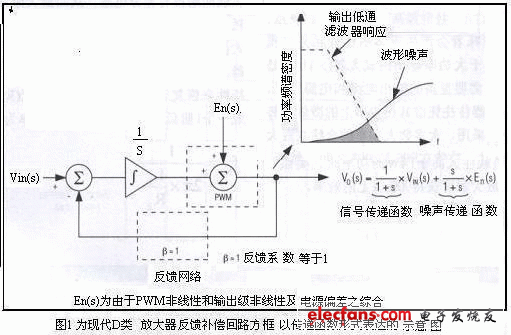Foreword
Today's EMI, which uses feedback networks and frequency expansion techniques to improve switching, has found application in switching regulators and modern Class D amplifiers in portable devices. What is the reason?
The high-efficiency characteristics of modern Class D amplifiers have become an ideal choice for portable and high-power applications in the ever-changing multimedia era. The reason for this is that many modern Class D amplifiers use advanced spread spectrum modulation technology, which can eliminate external filters and reduce electromagnetic interference (EMl) in various applications. The elimination of external filters not only reduces board space requirements, but also greatly reduces the cost of many portable / compact applications.
Because switching regulators can greatly save space and have extremely low power consumption, this regulator is gradually replacing linear regulators and entering various new applications. However, the switching regulator has a disadvantage, its internal switching current may generate EMI. The peak energy of EMI is concentrated on the switching frequency. The traditional method of reducing EMI is to carefully handle grounding, shielding and filtering. The above methods mainly focus on controlling and suppressing the radiation generated by the switching current in the regulator. In addition, reducing the amplitude of the switching current and changing the frequency can also reduce EMI. But to be precise, multiphase synchronization and spread spectrum frequency modulation (SSEM) and feedback network technologies are two powerful tools to reduce EMI. In addition, reducing the amplitude of the switching current and changing the frequency can also reduce EMI.
This article only analyzes and explains its feedback technology, spread spectrum modulation technology and a new generation of filterless Class D amplifiers. Because there is a basic understanding of Class D amplifiers and their latest technological developments, it will help designers choose the right amplifier for a specific application and correctly weigh the advantages and disadvantages of certain functional features. To this end, first of all, the problems existing in the traditional class D amplifier based on the PWM method should be introduced.
1. Problems with traditional Class D amplifiers
A major disadvantage of the traditional Class D amplifier is that it requires an external LC filter. This not only increases the total cost of the solution and board space, it may also introduce additional distortion due to the nonlinearity of the filter element. Many Class D amplifiers also use full-bridge output stages. The full-bridge circuit uses two half-bridge output stages and drives the load in a differential manner. This type of load connection is usually called a bridged load (BTL). The full-bridge structure works by switching the conduction path of the load. Therefore, the load current can flow in both directions without a negative power supply or DC blocking capacitor. Traditional, PWM-based BTL type D amplifiers output waveforms. The output waveforms are complementary to each other, thereby generating a differential PWM signal across the load. Similar to the half-bridge topology, an external LC filter is required at the output to extract low-frequency audio signals and prevent high-frequency energy from being dissipated on the load.
As with all traditional Class D amplifiers, a typical Class D amplifier based on the PWM method requires external filtering components, which will cause EMI / EMC compatibility problems, and THD + N performance is poor, so its high efficiency advantage is large compared to linear amplifier Discolored. However, modern Class D amplifiers use advanced modulation and feedback techniques to alleviate the above problems.
2. Use feedback network to improve performance
Many Class D amplifiers use a negative feedback loop from the PWM output to the device input. The closed-loop scheme can not only improve the linearity of the device, but also make the device have power supply suppression capabilities. Open-loop amplifiers, on the other hand, have very little power supply rejection. In a closed-loop topology, the output waveform is detected and fed back to the input of the amplifier, so it is possible to detect the deviation of the power supply at the output and correct the output through the control loop. The advantages of closed-loop design come at the cost of possible stability problems, which is also a common problem faced by all feedback systems. Therefore, the control loop must be carefully designed and compensated to ensure stability under any operating conditions.

A typical Class D amplifier uses a feedback loop with noise shaping function, which can greatly reduce the in-band noise introduced by the non-linearity of the pulse width modulator, output stage, and power supply voltage deviation. This topology is similar to the noise shaping used in sigma-delta modulators. In order to clarify the noise shaping function, Figure 1 shows a schematic diagram expressed in the form of a transfer function for a modern Class D amplifier feedback compensation loop, that is, a simplified block diagram of a first-order noise shaper. The feedback network usually contains a resistor divider network, but for simplicity, the feedback ratio in Figure 1 is 1. Since the gain of the ideal integrator is inversely proportional to the frequency, the transfer function of the integrator in the figure is also simplified to 1 / s. It is also assumed that the PWM module has unity gain and zero phase offset in the control loop. Using the basic control module analysis method, the following output expressions can be obtained:

From Equation 1, the noise term En (s) is multiplied by a high-pass filter function (noise transfer function), and the input term VIN (s) is multiplied by a low-pass filter function (signal transfer function). The high-pass filter of the noise transfer function shapes the noise of the class D amplifier. If the cut-off frequency of the output filter is selected properly, most of the noise will be pushed out of the band (see coordinate system in the upper right corner of Figure 1). The above example uses a first-order noise shaper, and most modern class-D amplifiers use a high-order noise-shaping topology to further optimize linearity and power supply rejection characteristics.
About silicone watch bands:
With the development of the society,people demand more and more high standard of live. In the same time,we can find out from their decorations, they are also beginning to pay attention to product safety and environmental protection, for example silicone watch bands. The Silicone Watch Band made of food grade silicone,It is very safe and good for the environment. Its texture is soft and durable,it can be clean easily and its dirty resistance is very good! many athletes and the office workers like it,even the old or young!
The following silicone watch bands photos for your reference:

Silicone Watch Band
Waterproof Watch Strap,Silicone Rubber Strap,Casio Watch Bands,Sport Strap Watch Band,Apple Watch Bands
OK Silicone Gift Co., Ltd. , https://www.oemsiliconegift.com